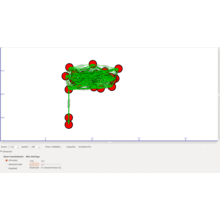Tag Archive: 'ns3 simulator'
Ethernet has become the primary network protocol used due to its undeniable advantages such as low cost, high speeds or ease of management. Being a best effort protocol, the IEEE Data Center Bridging Task Group developed a series of Layer 2 enhancements including Quantized Congestion Notification (QCN) and enabled a loss less environment. In this paper we […]
Software-Defined Networking not only addresses the shortcoming of traditional network technologies in dealing with frequent and immediate changes in cloud data centers but also made network resource management open and innovation-friendly. To further accelerate the innovation pace, accessible and easy-to-learn testbeds are required which estimate and measure the performance of network and host capacity provisioning approaches simultaneously within a data center. This is […]
OFDM technique has wide usage in modern communication systems, it can offer efficient use of frequency spectrum and high service quality for users. In literature, there are some software definedradio implementations of OFDM technique. OFDMA technique that can deliver advantages of OFDM technique to multi-user and dynamic based systems is more important for modern communications systems. In […]
This paper examines a possible vulnerability with the potential for a malicious entity to prevent a mobile device from handing over from a global system for mobile communications (GSM) to universal mobile telecommunications system (UMTS) network because the GSM network maintains the stand-alone dedicated control channel (SDCCH) uplink time slots. The process of testing this vulnerability requires the development […]
Software defined networks (SDN) provide flexibility for developing new network protocols and policies in real networks. The SDN controller translates network policies into specific rules in the flow tables (which are usually implemented using ternary content addressable memory (TCAM)) of each networkswitch. However, due to the limitation of TCAM (e.g., high power consumption and high heat generation), flow tables cannot scale beyond a few […]
Smart cities are becoming more and more popular primarily due to increasing TIC innovations and administrative efforts from city councils to better connect citizens through stateof- the-art technology. Currently a smart city is no longer focused just on offering administrative services, but on providing useful and pervasive information to citizens and serving as basic data […]
Opportunistic Internet of Things (IoT) extends the concept of opportunistic networking combining human users carrying mobile devices and smart things. It explores the relationships between humans and the opportunistic connection of smart objects. This paper presents a software infrastructure, named Opportunistic IoT Platform (OIoT), which helps developers to create and manage opportunistic IoT communities between smart devices. […]
Flash flood is a natural disaster that causes great losses; it happens mostly in rural areas. Heavy rainfall is gathered into the main river on watershed areas. Lots of water comes into the river. This causes a great volume of water flows down to the lower area of watershed. The great volume of water rapidly […]
In this paper, we investigate capacity scaling laws of wireless social networks under the social-based session formation. We model a wireless social network as a three-layered structure, consisting of the physical layer, social layer, and session layer; and we introduce a cross-layer distance & density-aware model, called the population-based formation model, under which: 1) for each node vk, the number of its friends/followers, denoted […]
Molecular communication holds the promise to enable communication between nanomachines with a view to increasing their functionalities and opening up new possible applications. Due to some of the biological properties, bacteria have been proposed as a possible information carrier for molecular communication, and the corresponding communication networks are known as bacterial nanonetworks. The biological properties include the […]

 Click Here to watch our latest output video using NS3 simulator
Click Here to watch our latest output video using NS3 simulator  Click Here to watch our latest projects screenshots using NS3 simulator
Click Here to watch our latest projects screenshots using NS3 simulator